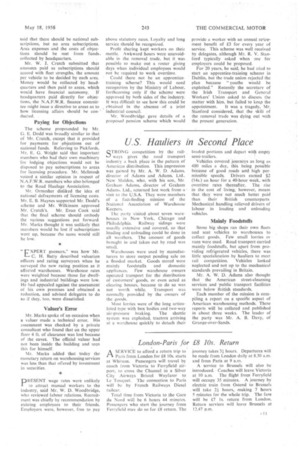U.S. Hauliers in Second Place
Page 51

If you've noticed an error in this article please click here to report it so we can fix it.
STRONG competition by the railways gives the road transport industry a back place in the pattern of American distribution. This impression was gained by Mr. A. W. D. Adams, director of Adams and Adams, Ltd., New Malden, who, with his son, Mr Graham Adams, director of Graham Adams, Ltd., returned last week from a visit to the U.S.A. They were members of a fact-finding mission of the National Association of Warehouse Keepers.
The party visited about seven warehouses in New York, Chicago and Philadelphia. Railway sidings were usually extensive and covered, so that loading and unloading could be done in all weathers. The amount of goods brought in and taken out by road was
Warehouses were used by manufacturers to store output pending sale on a flooded market. Goods stored were mainly foodstuffs and domestic appliances. Few warehouse owners operated transport for the distribution of customers' goods, or even acted as clearing houses, • because to do so was not worth while. Transport was normally provided by the owners of the goods.
Most lorries were of the long articulated type with box bodies and two-way air-pressure braking. The shuttle system was exploited, tractors arriving at a warehouse quickly to detach their loaded portions and depart with empty semi-trailers.
Vehicles covered jOurrieys as long as 400 miles a day, this being possible because of good roads aird high permissible speeds. Drivers earned $2 (14s.) an •hour fOr a 40-hour week, with overtime rates thereafter. The rise in the cost a living, however, meant that they were not much better paid than their British counterparts. Mechanical handling relieved drivers of labour in loading and unloading vehicles.
Mainly Foodstuffs
Some big shops ran their own fleets and sent vehicles to warehouses to collect goods. Few small lorries or vans were used. Road transport carried mainly foodstuffs, but apart from providing refrigerated vehicles, there was little specialization by hauliers to meet rail competition. Vehicles looked neglected and not up to the mechanical standards prevailing in Britain.
Mr. A. W. D. Adams also thought that the American street-cleansing services and public transport facilities were below British standards.
Each member of the mission is compiling a report on a specific aspect of American warehousing methods. These reports will be collated and published in about three weeks. The leader of the party was Mr. A. B. Davy, of Grange-over-Sands.
















































































































